After being quite exciting in its early days, Android Wear really lost whatever luster it initially had over the last two years. Google did a great job getting a good variety of more traditional fashion brands on board for new and interesting hardware throughout 2015 and even into 2016, but with the announcement of Android Wear 2.0 at Google I/O it kind of put the brakes on buying watches as we all knew new hardware would be coming with the final release of the software.
With a bit of a setback pushing the Android Wear 2.0 launch to 2017, we had to wait a bit longer to see the platform's "launch" watches: the feature-packed LG Watch Sport and the svelte LG Watch Style. The latter has its own draw in that it's sleek and sets itself apart from previous big Android Wear watches, but the LG Watch Sport is a true evolution of what you think of today as a full-power smartwatch.
It's relatively big, thick and filled with all sorts of features that showcase the brand new refocused Android Wear 2.0 software. This is the launch product for what Google hopes is a new wave of excitement about Android wearables, and that means it has to get it right with the $349 LG Watch Sport — see how it all comes together in our complete review.
About this review
I (Andrew Martonik) am writing this review after one week using the LG Watch Sport, connected to a Pixel XL over Bluetooth and with an active AT&T SIM in the watch. For testing purposes I was using pre-release version of some Google apps; the watch's software was not updated during the course of the review. The LG Watch Sport was provided to Android Central for review by Google.
Moving pictures!
LG Watch Sport Video review
Sometimes video shows it best. To see a condensed version of the LG Watch Sport review in video form, check out the video up above! Once you're finished, keep reading to see all of the details about this new smartwatch from LG and Google.

New big watch
LG Watch Sport Hardware
LG was there in 2014 for the original release of Android Wear, trotting out the boxy LG G Watch, and has also been one of the most active Android Wear partners since. So it's only fitting that it is the sole company kicking off Android Wear 2.0's introduction to the world. If you're an Android nerd like me you'll recognize the Watch Sport as a clear member of the LG Watch family, building on the history of round watches that it started with the G Watch R.
Before we get any further, here's a quick note on color options. The Watch Sport shown in this review is the "silver" model, which will be available everywhere this watch is sold. But there is also a "dark blue" model (looks black depending on the light) with black straps that will be available exclusively from the Google Store.
The LG Watch Sport is circular, thick and crafted out of a nice chunk of metal with a simple mix of lightly textured finish on the sides and a flat brushed finish encircling the display. Even though it packs a large 1.38-inch circular display, the metal casing keeps the bezel quite small. The two-tone brushed metal keeps the understated look going, making it less bulky feeling when compared to the likes of the Samsung Gear S3. LG has made the transition from metal to plastic on the back much smoother and less noticeable than Samsung as well.




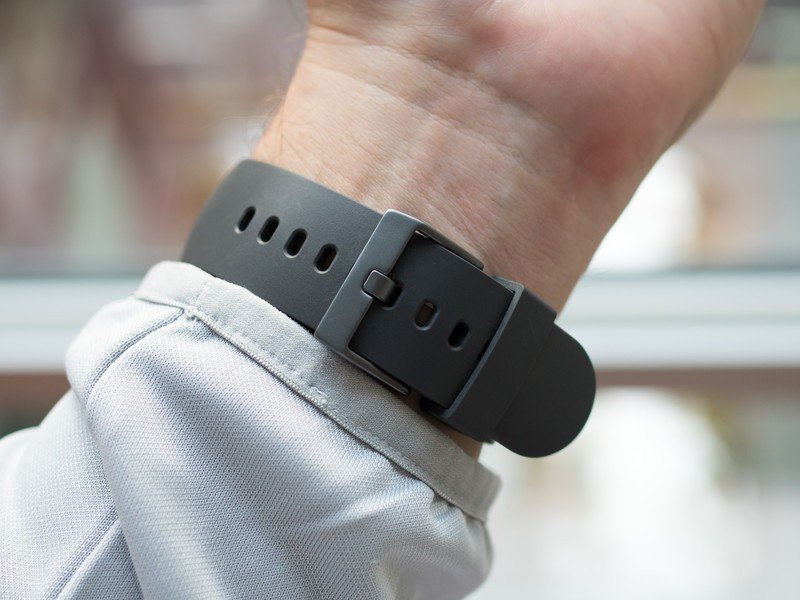
This is definitely still a big watch, though, further necessitating the simultaneous launch of the thin-and-light LG Watch Style for the two-thirds or so of the market who just can't handle a watch as big as the Sport. At 14 mm thick it still sits up off of your wrist a considerable amount, making it tough to even stretch a long sleeve over it.
More: Complete LG Watch Sport specs
Of course that thickness isn't just empty space — there's a sizable 430 mAh battery inside, as well as dedicated LTE, GPS and NFC radios and a heart rate sensor. It also gives you enough room on the case for three hardware buttons: a crown that also rotates for software interaction, and two customizable shortcut buttons.
The other part of the story with the LTE and NFC on the Watch Sport is that they necessitate having integrated TPU (Thermoplastic polyurethane) bands that aren't user-replaceable, as LG has tucked necessary radios into the bands themselves. Not only does that limit the flexibility of the band attachment points if you're trying to crank down the watch onto a smaller wrist, but some will also be put off by the lack of customization options. Again, this is where the LG Watch Style takes over with its standard swappable 18 mm lugs.
On the front of the watch, you'll find a typical great LG display. The P-OLED panel comes in at 480x480 resolution, and has a really small bezel that only slightly cuts into your screen real estate. It also offers an ambient light sensor for automatic brightness, without an unsightly flat tire. The display gets very bright but also very dim when needed, and generally looks great all around.

Refocused, redefined
LG Watch Sport Software
Android Wear 2.0 is a massive departure from previous releases, as it completely rethinks what's important on a smartwatch. Speaking ahead of the launch with David Singleton, VP of Android Engineering at Google, he explained that user feedback programs showed there were really three areas that consumers wanted their watches to be really great: watch faces, notifications and fitness tracking.
Focusing on the core experience ... but also, look at all of this other stuff!
Watch faces are now proper useful pieces of information rather than simply "form over function" displays that sit there waiting to be covered by notifications and apps. With the introduction of an API structure for complications, developers of both watch faces and apps can build to each other's benefit. Watch faces can have slots for a number of complications, which are user-customizable with various system-level utilities and third-party apps alike. App developers can choose what data to surface when a user places their app in a complication slot, and watch face developers can choose how they want to display it.
Notifications have also been simplified to require fewer swipes and taps. Apps can surface their most-used function to be visible at the bottom of a notification, saving you an extra swipe to perform that common action. For example, messaging and email apps surface simple one-tap buttons for actions like replying to or archiving messages. These new actions can be seen surfaced at the bottom of many parts of the Android Wear 2.0 experience, saving you time while also hiding fewer buttons from view.
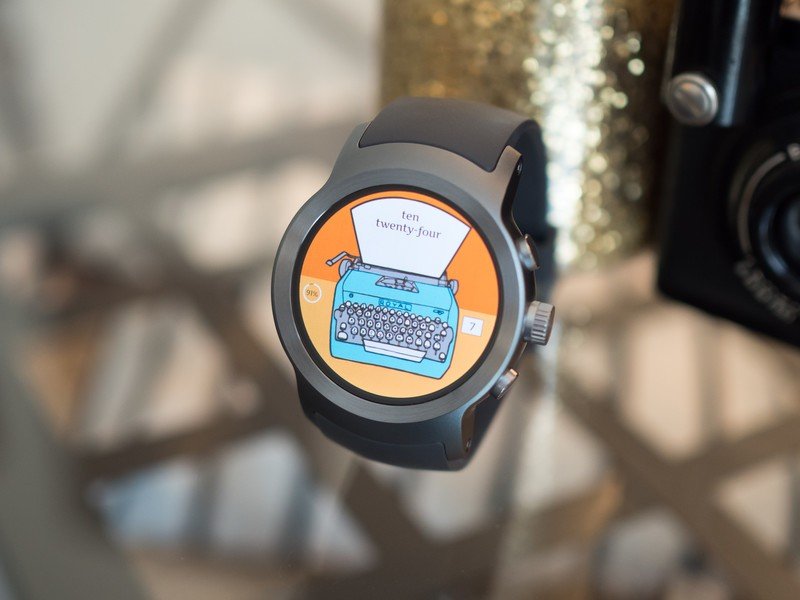
Our complete Android Wear 2.0 review!
Android Wear 2.0 is a complete overhaul of Google's wearable platform, from interface and design to apps and functionality. For the complete breakdown of everything that's new in the latest release, be sure to read our complete Android Wear 2.0 review.
Read our complete Android Wear 2.0 review here!
Interestingly, Android Wear also puts in many deeper levels of interaction for those who want to do more with their watch. The ability to add a standalone LTE connection to your watch is a great indication that Android Wear devices are now designed to operate (at least sometimes) independently of your phone. App developers can now create watch apps that don't require a companion app on your phone, and at the same time when you install an app on your phone it doesn't automatically push a companion app on your watch. I far prefer this approach, particularly if you're someone who won't be using a ton of apps on the watch itself — you can keep things clean, on your terms.
Google has also brought over a somewhat-limited version of Google Assistant to Android Wear 2.0. Through either a long press on the crown or a mention of "OK, Google" you can launch Assistant, and ask it just about anything you'd ask of your Pixel or Google Home. Integrations with things like smart home devices aren't yet here, but simple queries about the weather, navigation, messaging, search terms or simply launching an app all work just fine. There's a considerable speed difference between the watch and a Pixel performing the same task, though, limiting its realistic usefulness to situations where you don't have a phone or Google Home nearby.


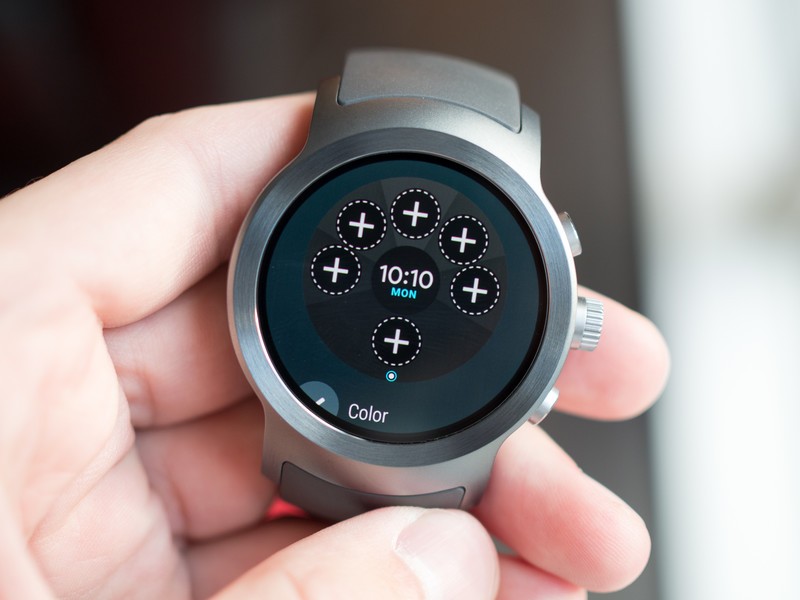
Perhaps my favorite part about the Android Wear 2.0 update is its new emphasis on "rotational input." The new interaction method lets companies create smartwatches that can use other forms of input than just the touch screen, like LG did with a rotating crown on the Watch Sport and Watch Style. Rotational input isn't simply translating spinning hardware into touch, either — it's a whole new form of interaction that developers have to specifically target and choose what to do. For example it's used for scrolling throughout the interface, but zooming on Google Maps — developers can run with it.
The rotational input isn't just limited to crowns, though — it could perhaps be a fully rotating bezel, or something else entirely. I absolutely love using the crown throughout the interface — it makes getting through long lists a breeze, while at the same time making it easier to move precisely through an app without covering the content you're trying to navigate. And yes, I have to give the nod to the Gear S2 (and to a lesser extent, Apple Watch) for getting to this idea first.

Big improvement
LG Watch Sport Experience
The combination of this refreshed Android Wear software experience and new hardware that actually feels modern gives me a renewed sense of hope about Android Wear. The new wearable-tuned Snapdragon Wear 2100 processor pairs up with 768MB of RAM to give you a slick and smooth experience, and if you keep to basic tasks you won't ever be waiting for something to load longer than you would expect. Heavier tasks like some full-blown apps (like Google Maps) or those that need heavy network access (like Google Assistant) take a few extra beats, but this is a few massive steps ahead of the performance on older models using a Snapdragon 400.
As someone who really has little desire to use the more advanced features of Android Wear (or really any smartwatch) because they quickly become frustrating on a tiny screen, I'm very happy with the way the LG Watch Sport performs.
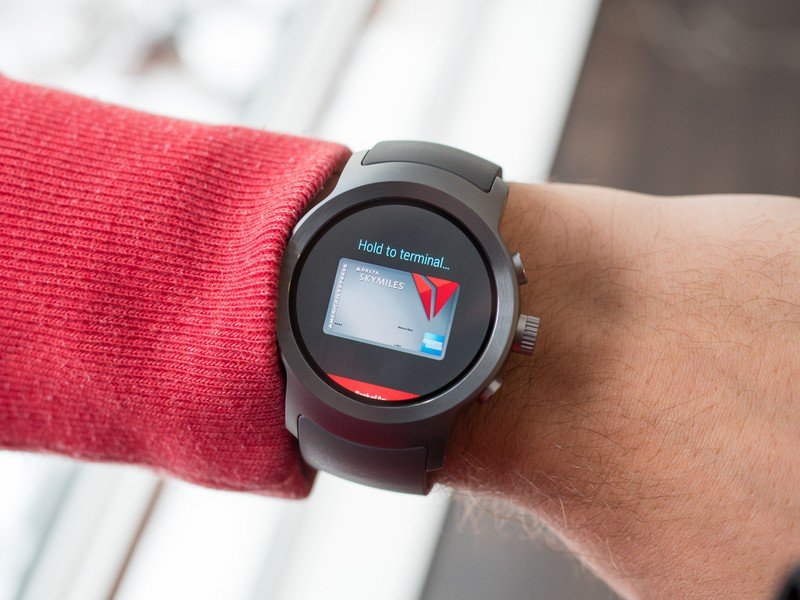
Android Pay
Yes, you can finally pay for things with just your watch! Android Wear 2.0 introduces the mobile payments for devices that choose to include NFC (like the LG Watch Sport, but not the Watch Style). Setup is quick, assuming you've already configured Android Pay on your phone. You can set a default payment card on the watch, and see a payment history when you tap into each card.
Finding the tap-to-pay point is extra awkward when you're using a smartwatch.
You can quickly fire up Android Pay by opening the app or assigning it to one of the customizable case buttons, and it's immediately ready to pay. In the case of the LG Watch Sport you place the top portion of the watch — where the band meets the case — to the terminal, and it gives you a satisfying vibration to let you know the payment went through.
Paying with your wrist is nice if you live somewhere that has finally started to adopt new payment terminals with NFC. Just be prepared to get a few awkward looks as you figure out where, exactly, the tap-to-pay areas are on some of the newer terminals. It all looks so much more awkward when you're trying to do it with your smartwatch.
Fitness tracking
The "Sport" designation means this is a smartwatch suited for working out and generally sticking with you as you stay active, and that has come with a solid improvement to the default Google Fit app. By default Fit is mapped to the top button on the watch, which can launch you into a workout with a single tap. Of course all of the data syncs back to the Google Fit app on your phone, tracking your activities over time and breaking down all of your actions.
Google Fit received a much-needed update to cover most of your fitness needs.
With minimal setup you can get tracking right away with the LG Watch Sport, even if you don't set up the Fit app on your phone first. You can enter your height and weight, then be off to the races with tracking your daily step count, as well as your heart rate through a higher-end and more accurate PPG heart rate sensor. Google Fit can handle walks and runs pulling GPS data from your connected phone, or if you want to stride freely you can use its integrated GPS instead. Without starting explicit workouts Fit will track your movements and estimate when you went on a walk or run, but won't kick in the GPS without your permission. At the end of the day you get a nice breakdown of your steps, active time, calories burned and distance walked, if you're interested.
You can, of course, go beyond just walking and running with Fit — from standard gym machines to body weight exercises, Fit can help you track everything if you tend to vary your workouts. The size of the Sport could be a hindrance for some gym workouts, but that will be up to your personal preference. If you decide to bring the Sport with you, it can pair to Bluetooth headphones and play music without your phone — a forthcoming Google Play Music update will let you stream music over LTE and Wi-Fi as well. IP68 water resistance lets the Watch Sport handle sweat and rain without issue, but won't protect it when you go for a swim.

Battery life
I recently reviewed the Samsung Gear S3 Frontier LTE, and quickly saw how much stress LTE and GPS could put on a smartwatch. Now I'm using an Android Wear watch with the same features, and am of course seeing the same results. Keeping LTE turned on significantly cuts into the battery even if you're primarily connected to a phone over Bluetooth, as the mobile data has to be idly available for incoming calls and connections.
Battery life is great, provided you don't actually use LTE.
On my first couple of days using the LG Watch Sport, getting settled in and using it more than typical to get acquainted with it, I hit 15% battery — which triggers "battery saver" mode — at around 4 p.m. after having taken it off the charger just before 9 a.m. that morning. That included a couple of walks pulling GPS from my connected phone, transferring some tracks that I downloaded in Google Play Music and several requests to Google Assistant — all with LTE and Wi-Fi turned on (they idle when Bluetooth is connected), and notifications pinging my wrist.
That's pretty good considering it's what I'd call above-average use, but that still means I'm putting the watch on a charger at dinnertime rather than making it the "full day" that LG claims. Further on in my week of testing when I was using the watch a bit more normally and trialed turning off LTE (as a majority of people will experience it), battery life improved dramatically. Standby battery was great, and I regularly went to bed after 14 hours off the charger with 30% battery left. So, not enough to get 2 days without charging ... but plenty left in the tank to always make it through a full day — again, so long as you don't use LTE.
LTE on your wrist
Mobile data on a smartwatch isn't something that everyone is clamoring for, and definitely isn't a feature you'll find everywhere in the market, but after dipping its toe in with the LG Watch Urbane 2nd Edition LTE (that name ...) it's back at it again here. Just like Samsung's last few smartwatches, you can get a distinct data plan from your carrier — AT&T and Verizon at launch — that gives your watch its own connection that can be used for calls (yes, over the watch loudspeaker) and texts, all synchronized with your phone.
Few will be willing to pay $5-10/month for LTE on a watch.
You can also use that connection to operate the watch independently outside the range of your phone's Bluetooth connection. That means you can use Android Wear's new standalone apps to load maps, send and receive messages, stream fresh music from Google Play Music and generally keep up with the world. Adding LTE to the equation doesn't mean you have any more room to work with on the watch, though, so remember you're still dealing with a limited operating system on a 1.38-inch display.
Even though you can buy the LG Watch Sport from AT&T or Verizon, that doesn't mean you have to. You can buy it unlocked for the same $349 price from Google (and other retailers) directly, and simply use it with Wi-Fi and Bluetooth (including GPS) as you would any other smartwatch. In the end I expect a small minority will see the value in paying $5-10 per month for LTE on their watch — I sure don't see the value in it myself.
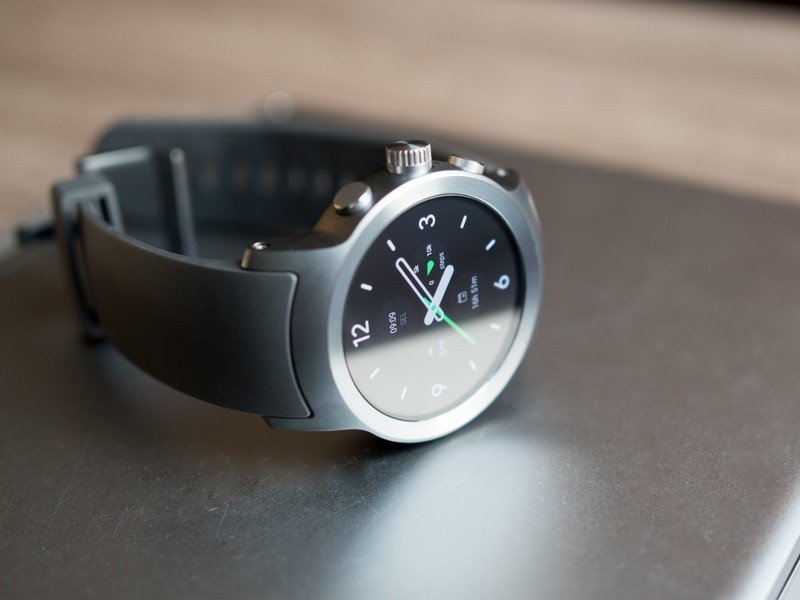
A new era
LG Watch Sport Bottom line
Google still has an uphill battle ahead trying to get a notable number of people interested in smartwatches. Comparing to the scale of Android phone sales, Android Wear is just a tiny blip on the radar — and it's going to take many iterations of this platform to improve adoption. Android Wear 2.0 and the LG Watch Sport are a great combination pushing toward that goal of getting Google-powered wearables on more wrists around the world.
Many technology enthusiasts will still be wooed into considering the LG Watch Sport, even at $349. The allure of a fresh smartwatch that fixes many pain points of previous Android Wear watches will be strong. It has a great display without a dreaded flat tire, a nice case that is unfortunately a bit too thick but has great build quality, and every feature you could want crammed inside. It's a proper antithesis to its launch companion, the LG Watch Style, and when viewed together as a product portfolio they both make more sense.
Sure, the LG Watch Sport won't be the watch for everyone — in fact, the cheaper and simpler LG Watch Style is perhaps more likely to succeed — but it's a great piece of hardware to put all of Android Wear 2.0's capabilities on display. The new software incorporates two years of feedback on how we use smartwatches, and in general does a good job of hitting the features we want most on our wrist. Quick and functional interactions with the basic features, along with a few extras for those who need to do more, make this a clean separation from Android Wear of the past.
The LG Watch Sport is for the wearable fan who wants to experience Android Wear 2.0 to the fullest right from the start, and see the latest Google has to offer on some great hardware from LG.
More: Where to buy the LG Watch Sport
Andrew was an Executive Editor, U.S. at Android Central between 2012 and 2020.


